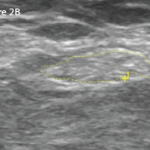
Shidlovski / shutterstock.com
After total hip or knee arthroplasty, flares are common in patients with rheumatoid arthritis (RA), according to a recently published study.1 Higher disease activity at baseline appears to be linked to flares, but use of such medications as biologics and methotrexate did not independently predict flaring.
“Contrary to the notion that patients with established RA have ‘burnt out’ or inactive disease at the time of arthroplasty, the majority of patients with RA undergoing arthroplasty are taking DMARDs [disease-modifying anti-rheumatic drugs] and biologics to control joint inflammation,” wrote Susan M. Goodman, MD, of the Department of Rheumatology and Orthopedics at the Hospital for Special Surgery in New York City, and fellow researchers. They cited research that found 40% of patients with RA having total knee replacement and 34% of those having hip replacement were being treated with biologics, while up to 67% were being treated with DMARDs. “These therapies are often stopped prior to surgery, a practice that may increase the risk of flare in the perioperative period,” the researchers wrote.
Discontinuation of biologics before surgery is standard because of the increased risk of prosthetic joint infection in patients with RA. Both the ACR and the American Association of Hip and Knee Surgeons have weighed the risk of flares against the risk of infection, the researchers reported.2,3 RA flares frequently occur, and this is commonly linked to medication withdrawal. The resulting pain and fatigue may make rehabilitation more challenging, but this is weighed against the increased infection risk posed by continuing medications.
The Study
Researchers in this prospective study focused on RA patients who were recruited prior to elective total knee arthroplasty and total hip arthroplasty at the Hospital for Special Surgery. Although 23,584 patients presented in the study’s time period for total joint arthroplasty, 23,406 did not meet the inclusion/exclusion criteria or they declined to participate. Ultimately, the study included 120 patients in the six-week analysis.
Characteristics of RA were evaluated at zero to two weeks before elective knee and hip replacement, and at six weeks postoperatively. Patients also answered questions about their disease activity, including self-reported joint counts and flare status weekly for six weeks. Patients stopped using biologics before surgery, but glucocorticoids and methotrexate were typically continued.
Data collected at baseline included age, sex, comorbidities, disease duration, medications, the MD Health Assessment Questionnaire (MD-HAQ), Routine Assessment of Patient Index Data (RAPID)-3 and the 28-joint Disease Activity Score (DAS28). Both serologic status for rheumatoid factor and anticitrullinated protein antibody were obtained, as were joint counts at each visit (excluding the operated joint), inflammatory markers, DAS28, MD-HAQ and RAPID-3.
Flare status was assessed via physician review of aggregate data. Patients also completed the Rheumatoid Arthritis Flare Questionnaire (RA-FQ) each week up to six weeks postoperatively, as well as the RAPID-3 and the tender-painful joint region score modified from the Rheumatoid Arthritis Disease Activity Index questionnaire. “[Although] flare status did not require MD-patient concordance, discordance was minimal,” the researchers wrote.
Among the 120 patients in the analysis, 83% were female, 81% were white and 44% underwent total hip replacement.
Researchers found no any major differences in patients, disease characteristics or flare rates among those having total knee vs. total hip replacement. Disease flare occurred in 63% of patients, with a median time to flare after surgery of two weeks. The median severity of flares was 7 on a scale of 1–10, with a median duration of four to seven days. Twenty-two patients flared on the day of surgery (baseline), but there was no difference between those with baseline vs. post-baseline flare.
Flaring patients were more likely to be treated with biologics than with other agents (57% vs. 42%, P = 0.14). Researchers found no difference among flarers treated with biologics (51% for flarers vs. 53% for nonflarers) or glucocorticoid use on the day of surgery (88% for flarers vs. 86% for nonflarers).
Disease activity was higher at baseline for patients who flared; they also had higher DAS28-joint count, C-reactive protein (CRP) and erythrocyte sedimentation rate (ESR) and Clinical Disease Activity index, as well as RAPID-3. “Inflammatory markers such as CRP and ESR were higher at baseline in flarers, and the number of tender joints … and the number of swollen joints were significantly higher,” the researchers wrote.
At baseline and at six weeks, flarers had significantly worse MD-HAQ function, although the change from baseline to six weeks was similar between the flarer vs. nonflarer groups. Participants with flares noted they reduced the amount of activities they did, rested more and avoided activities they had planned to do. Seventeen percent increased analgesics or anti-inflammatories, and 5% increased glucocorticoids to manage flare. “Only 4% sought help from their rheumatologist,” the researchers wrote.
Patients who met both the 2010 and 1987 RA classification criteria had a greater than fivefold increase in flare risk (OR 5.89, P = 0.002). Flare risk also appeared higher in those with higher disease activity at baseline, and in patients with high disease activity by DAS28-ESR and elevated RAPID-3.
There was a decreased risk of flare with a CRP less than or equal to 1.5 mg/dL and less than or equal to 2.0 mg/dL. “However, neither disease duration nor medication use, including biologics, increased the risk of flares; discontinuation of a biologic greater than two-dose intervals prior to surgery did not increase the risk of flares. Use of methotrexate at the time of surgery did not independently protect against the risk of flares,” the researchers wrote.
Note: Study limitations noted by the authors included the possibility of bias if physicians encouraged patients with more severe RA to enroll. It is also possible that the results are not generalizable because the study was performed in a tertiary care hospital with a high RA-specific arthroplasty volume. The study did not have a control group.
Take-Home Messages
The study results are intriguing because they address something not often examined scientifically, said Stuart Kaplan, MD, chief of rheumatology at South Nassau Communities Hospital in Hewlett, N.Y. “The better control you have before surgery, the less likely you are to have a flare afterward. That’s a major take-home message for me. Try to get patients in as good control as possible before surgery,” Dr. Kaplan said.
These findings make intuitive sense, said Dr. Kaplan, adding that he will work with patients to get their RA under optimal control before knee or hip arthroplasty. “It’s a matter of getting them on the right meds, which usually includes methotrexate or biologics and sometimes a little bit of steroids.”
The current standard perioperative care is to stop biologics at the time of arthroplasty to lower the infection risk, the researchers noted in their discussion section. Prosthetic joint infections remain high in RA patients, and there is also a growing rise of infections among patients with RA within 90 days of arthroplasty.
“Despite improvement in the status of patients with RA, poorer outcomes are still reported after arthroplasty, raising concern that postoperative flares linked to withholding medication might affect rehabilitation efforts and outcomes,” the researchers wrote.
“The notion that patients with established RA undergoing [total hip or knee arthroplasty] have ‘burnt out’ disease lends further credence to the spreading idea that RA is an ongoing disease over a lifetime, at best controlled by medication,” the researchers concluded.
Researchers are continuing to collect follow-up data to determine if flares after surgery, when patients are trying to focus on postoperative rehabilitation, have any long-term impacts on pain and function, Dr. Goodman said.
One other interesting aspect of the study, according to Dr. Goodman, is that it has permitted the clinician group to collaborate with basic science researchers to study the target tissue in RA.
Vanessa Caceres is a medical writer in Bradenton, Fla.
Reference
- Goodman SM, Bykerk VP, DiCarlo E, et al. Flares in patients with rheumatoid arthritis after total hip and total knee arthroplasty: Rates, characteristics, and risk factors. J Rheumatol. 2018 May;45(5):604–611.
- Saag KG, Teng GG, Patkar NM, et al. American College of Rheumatology 2008 recommendations for the use of nonbiologic and biologic disease-modifying antirheumatic drugs in rheumatoid arthritis. Arthritis Rheum. 2008 Jun 15;59(6):762–784.
- Goodman SM, Springer B, Guyatt G, et al. 2017 American College of Rheumatology/American Association of Hip and Knee Surgeons guideline for the perioperative management of antirheumatic medication in patients with rheumatic diseases undergoing elective total hip or knee arthroplasty. J Arthroplasty. 2017 Sep;32(9):2828–2838.


